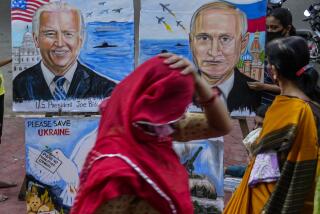7 South Asian Leaders Meet to Form Regional Cooperation Group
DHAKA, Bangladesh — The first summit meeting of South Asian leaders--including two kings, two generals, two presidents and a prime minister--convened here Saturday to launch the world’s newest regional group, the seven-nation South Asian Assn. for Regional Cooperation.
India, the largest and most developed of the countries, quickly emerged as the key force in the new political and trade bloc.
Representing more than one-fifth of the world’s population, the South Asian association, dubbed SARC, has been described as “the poor man’s club” because its members represent some of the globe’s most impoverished and backward peoples, including those here in overpopulated Bangladesh.
“Today, in terms of economic and social well-being, the situation in our region could not be more dismal,” said Jigme Singye Wangchuck, king of the small Buddhist mountain state of Bhutan. “The region’s 1 billion people, representing one-fifth of mankind, live on 3% of the global land area, with a per-capita income of less than one-tenth of the world’s average.
The Big and Small
The South Asia grouping, covering most of the area that once formed Britain’s India empire, is modeled on similar regional cooperation organizations--ASEAN in Southeast Asia and the Gulf Cooperation Council in the Persian Gulf. Its members range in size from the tiny republic of Maldives, a chain of islands in the Indian Ocean with a population of only 156,000, to India, the world’s second most populous country, with over 740 million inhabitants. Other members include Pakistan (93 million), Bangladesh (100 million), Nepal (16 million), Sri Lanka (15 million) and Bhutan (1.3 million).
The Bangladeshi president, Lt. Gen. Hussain Mohammed Ershad, was named chairman of the group by the other leaders at the morning session Saturday. But India, with its young prime minister, Rajiv Gandhi, emerged as the power of the organization, which hopes to resolve nagging regional conflicts and build trade between members.
Said Sri Lanka’s President Junius R. Jayewardene, in the most candid of the inaugural addresses:
“India, the largest in every way--larger than all the rest of us combined--can by deeds and words create the confidence among us so necessary to make a beginning.”
Hopes Rest With Gandhi
Turning from the podium in the Bangladesh National Assembly building to face Indian leader Gandhi, Jayewardene, at 79 the oldest of the seven leaders and the most politically experienced, added:
“Rajiv Gandhi is the chosen leader. On him we rest our hopes. He must not fail us. He cannot. Our duty is to help him to the utmost. He should tell us what each of us should do, and we must respond as best as we can.”
With the exception of the Sri Lankan president’s rather stirring speech, most of the leaders steered away from emotion or controversial issues in their remarks opening the two-day conference.
Bhutan’s young King Wangchuck, dressed in a traditional Bhutanese robe called a kho, alluded to the most controversial issue facing the region, the accelerating nuclear arms race between India and Pakistan.
Arms Race Deplored
“In our own region, it is regrettable to note that the arms race has intensified and assumed new dimensions with the increasing possibility of the development of nuclear weapons,” said the 30-year-old monarch, who inherited his throne.
Both Gandhi and his Pakistani counterpart, President Zia ul-Haq, warned against the nuclear arms race, and Zia urged steps “to banish nuclear weapons” from the region.
Bangladesh’s martial-law ruler Ershad had hoped that the conference would boost his sagging image here. He ordered giant portraits of himself and other leaders placed along the road leading from the airport to the city’s two major hotels. Brightly colored wooden arches were placed over the road and nearly every building was festooned with blinking colored lights.
However, the very site of the meeting, the 14-year-old National Assembly building, was itself an example of the kind of internal problems faced by the seven countries, only three of which--India, Sri Lanka and Maldives--have democratically elected leaders.
Building Rarely Used
The magnificent assembly building, the Jatiyo Sangsad Bhaban, was designed by the American architect Louis Kahn when Bangladesh was still part of Pakistan. It was finished in 1981 at a cost of $53 million, but since then has been used only twice--for a brief meeting of the since-disbanded National Assembly and for a conference of Islamic foreign ministers.
Trade between the member countries is minimal.
For example, Pakistan this year imported wheat from the United States and Australia while India, across the border, had a surplus.
More to Read
Sign up for Essential California
The most important California stories and recommendations in your inbox every morning.
You may occasionally receive promotional content from the Los Angeles Times.










